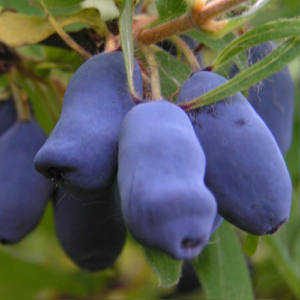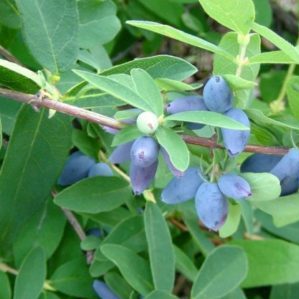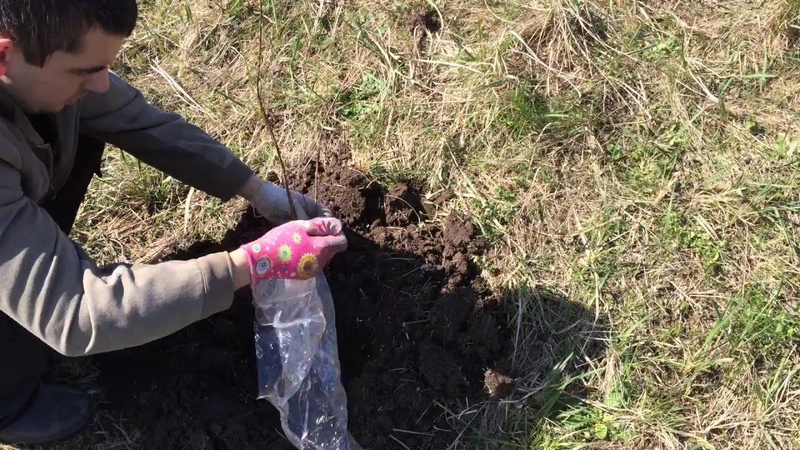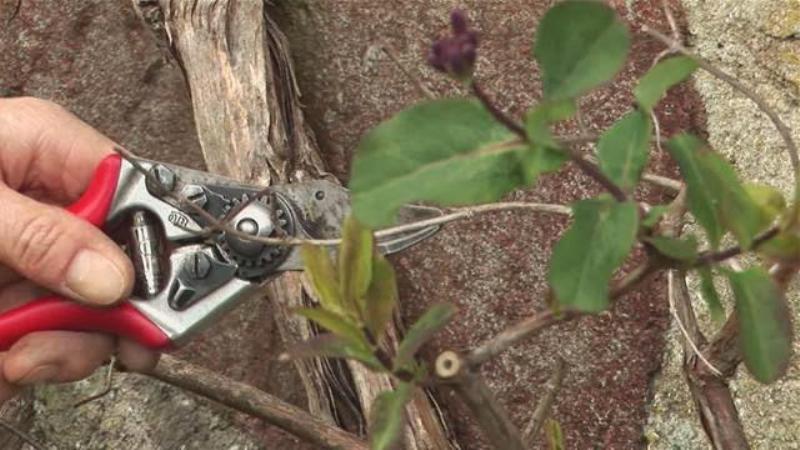Frost-resistant honeysuckle variety "Pavlovskaya" with large sweet berries
Honeysuckle is becoming more and more popular in horticulture. Over the past 30 years, several dozen varieties of this shrub have been bred. It is especially popular in the northwest of Russia. There are several reasons: this is the earliest berry, it is easy to grow and care for, and has a delicious taste.
From the article you will learn all the most important about the Pavlovskaya honeysuckle variety with large and sweet fruits.
The content of the article
What is this Pavlovskaya honeysuckle variety
Pavlovskaya was bred on the basis of the second generation of Kamchatka honeysuckle hybrids in Pavlovsk at the All-Russian Institute of Plant Industry and was included in the State Register of Fruit Plants in 2000. The Latin name is lonicera Caerulea Pavlovskaya. Authors - a group of scientists: Plekhanova M.N., Teterev F.K., Koroleva Z.A.
Pavlovskaya honeysuckle is widespread in regions with a temperate climate, in particular, in the northwestern regions of Russia.

Characteristics and description of the bushes
The Pavlovskaya variety has all the characteristic features of the species. It is a shrub of medium size, inversely conical in shape with straight thick branches. Leaves are oval, light green. Young branches are densely pubescent with leaves, but become bare with age. The bark is light brown, may peel off in stripes. The height of an adult plant is up to 2 m, diameter is up to 3 m. The bush begins to bear fruit at 3-4 years of age.
Interesting! Thanks to its dense, compact crown with a rigid skeleton of branches, honeysuckle is used as a difficult green fence.
The shrub lives and bears fruit in one place for up to 30 years.
Honeysuckle flowers are usually paired, located in deciduous sinuses, irregularly shaped in the form of a funnel of yellowish or pinkish color. The bush blooms in April - May.
Honeysuckle Pavlovskaya is a wonderful honey plant.
Resistant to temperatures
Hybrid Pavlovskaya is a winter-hardy variety that can withstand temperatures below 30 ° C, does not require winter shelter. This is a very attractive quality for northern gardeners.
Honeysuckle flowers are not afraid of recurrent frosts and can withstand temperatures below 0 ° C.
Attention! In areas with harsh winters, the bush is insulated by wrapping it in non-woven material.
The Pavlovskaya variety easily tolerates sunshine and high temperatures, prefers to grow in sunny places.
Moisture and drought resistance
Honeysuckle Pavlovskaya withstands long periods of drought. However, when ripe berries the plant must receive sufficient moisture, otherwise they will taste bitter. Water the bushes with standing water or rainwater.
Honeysuckle bushes should grow on well-drained soil, 1 m higher than the groundwater depth, since they do not tolerate stagnant water. In this case, the root system rots, and the plant dies.
Disease and pest resistance
One of the indisputable advantages of the Pavlovskaya variety is its high resistance to diseases and pests. However, if the plant is weak or the weather conditions are unfavorable, diseases and pest attacks are possible.
In wet and cool summers, powdery mildew affects honeysuckle. In this case, the bushes and the soil under them must be sprayed with fungicidal preparations "Topaz", "Skor", "Horus".
In unfavorable years, the following pests attack the plant:
- Aphid feeds on the juice of young shoots and is grouped on the tops of the branches. This insect is in symbiosis with ants that settle next to the bush. Against aphids, they are treated with bitter solutions of wormwood, garlic, pepper, or the bushes are sprayed with insecticides ("Iskra", etc.).
- Red spider mite - its size is 0.2 mm, it is almost invisible to the naked eye. A thin web can be seen on the back of the leaves. The mite feeds on the sap of the leaves, as a result, the leaves are covered with small yellow or brown spots. The bush is sprayed with a solution of laundry soap or treated with an insecticide "Aktofit", "Envidor", "Koragen".
Check the bushes periodically and treat them in time if pests are found.
Important! If the plant is strong, and the place for planting is chosen correctly, Pavlovskaya honeysuckle practically does not get sick.
Characteristics and description of fruits

Honeysuckle is prized for its delicious sweet and sour taste. Berries of Pavlovskaya variety are sweet with sourness and light bitterness. Fruits are large, oblong, up to 3 cm long and weighing up to 1.6 g, painted blue with a waxy coating.
The yield of an adult bush reaches 4 kg. This variety is of medium ripening, the berries ripen at the end of June.
Attention! It is believed that the more pronounced the sour taste, the healthier the berry!
Their scope
Honeysuckle fruits are used for food:
- fresh;
- they are used to prepare juices, jams, compotes, pie fillings;
- make wine;
- frozen for future use.
In folk medicine, berries are used fresh and in the form of alcoholic tinctures for the following pathologies:
- hypertension;
- stomach ulcer and 12 duodenal ulcer;
- diseases of the kidneys and genitourinary system.
Honeysuckle plays only an auxiliary role in complex therapy.
Advantages and disadvantages of the variety
Honeysuckle variety Pavlovskaya was created for cultivation in mid-latitudes and has a number of indisputable advantages:
- high frost resistance and drought resistance;

- with proper leaving the plant practically does not get sick;
- undemanding to soil;
- the fruits are large and have excellent taste;
- low shedding of berries from a bush when ripe;
- berries tolerate transportation well;
- grows and bears fruit for a long time in one place;
- the bush is decorative and does not require supports.
Disadvantages:
- does not tolerate excess moisture in the soil;
- requires "neighbors", honeysuckle of other varieties for cross-pollination (Blue Bird, Tomichka) - the berries will be tastier and larger.
Growing technology
The cultivation technique of the Pavlovskaya variety is simple, since the plant is resistant to external factors.
Optimal conditions
For the successful growth and development of the shrub, a sunny place is chosen. The sun should illuminate the plant all day and at any time of the year. A place landing - at a low elevation to avoid stagnant groundwater. The location of the bushes should not be heavily blown. Associated with this are the risks of frostbite on branches in winter.
Terms and rules of landing

Planting dates are determined by the quality of the seedling. If the root system is open, it is better to plant the plant in spring (April) or early fall. At this time, the air temperature is moderately warm and it is easier for the plant to adapt. With a closed root system (plant in a container), it is planted in the ground at any time during the warm season.
Work progress:
- Dig a hole, the size of which exceeds the volume of the root system by 5 cm.
- A drainage layer (expanded clay, broken brick, thick branches) is laid at the bottom of the pit.
- Add organic fertilizers (rotted manure, compost, ash) to the pit. This will allow you not to fertilize the bush for the next 3 years. Do not use fresh manure when placing fertilizer in the pit. The roots will burn.
- Water the pit abundantly.
- Place a seedling in it, straighten the roots, sprinkle with earth, tamp the earth around the trunk with your feet. Do not deepen the neck more than 3 cm.
- Water the planted plant liberally.
Further care
After planting Pavlovskaya honeysuckle, in dry weather, the plant is watered at least 1 time per week, do not allow the trunk circle to dry out.
The earth under the bushes is weeded and mulched with dry grass and tree bark. This will get rid of weeds and provide optimal moisture in the root zone.
2-3 years after planting, honeysuckle bushes are fed with complex fertilizers 2-3 times per season.
Wintering
If the frosts in your region are not below 30 ° C, then the bush does not require shelter for the winter. However, the trunk circle for the winter is mulched, since the superficial root system of honeysuckle can be frostbitten.
If the winters are cold and windy, it is worth insulating the plant by wrapping the bush with non-woven material.
Reproduction
Honeysuckle varieties Pavlovskaya are propagated in three ways:
- Cuttings. They are taken in the spring from an adult plant before bud break and placed in a nutrient medium or in wet sand until roots appear.
- Seeds. Overripe berries are kneaded and spread on a paper napkin. Placed in a nutrient soil to a depth of 5 mm. When the plant has risen and three leaves have appeared, it is planted in open ground.
- Layers. The lateral branch of the bush is bent to the ground, pressed with a bracket or stone and covered with soil. During the season, a branch in the ground will take root. She is separated and put in a new place.
Features of growing this variety, depending on the region

Honeysuckle Pavlovskaya is ideal for middle latitudes with a temperate climate. She is known in Europe, Belarus and Ukraine. Based on the properties inherent in the variety, it is grown everywhere, except for the far north, deserts and areas with high humidity.
The chemical composition of the fruit depends on the growing region. So, in berries ripened in the temperate zone, the content of sugar, acids, vitamin C is higher than in honeysuckle grown in Altai or Primorye.
Pollinating varieties
The Pavlovskaya honeysuckle variety is self-infertile. The plant needs pollinators. The most suitable varieties for this purpose are Blue Bird, Tomichka, Vasyugan, Blue Spindle.
There is an opinion! The more varieties of pollinators in the garden, the higher the yield.
Pollen is carried from one bush to another by insects, bees. The correct selection of pollinators is important. The yield depends on this.
Gardeners reviews
Most gardeners leave positive reviews about Pavlovskaya honeysuckle.
Irina, Kaliningrad: “I got this variety 5 years ago. I specially went to the nursery. I am very pleased, the plant is not capricious in its care, but what high yields it gives. The berries are not small, which pleases. "
Ksenia, Ufa: “A neighbor helped with the propagation of the bush, took a cutting from her. I thought it wouldn't take root, it took root surprisingly quickly. Then there were fears after transplants into open ground. But here, too, the sprout quickly took root. Now after 4 years I have been consistently getting a good harvest of sweet and sour berries ”.
Angelina, Arkhangelsk: “I bought Pavlovskaya honeysuckle from a photo, at random. I liked the variety very much. Leaving does not take a lot of time and a lot of hassle. The main thing is watering, feeding and trimming spend on time. I was also glad that pests do not attack the bush, and the plant does not get sick with anything serious. "
Conclusion
Due to its many positive properties, the Pavlovskaya honeysuckle variety has a large army of fans among gardeners. It is ideal for growing in central Russia. She has the sweetest berries known. Honeysuckle has high yields with the right pollinator selection, is easy to grow, easy to care for and good for your health.